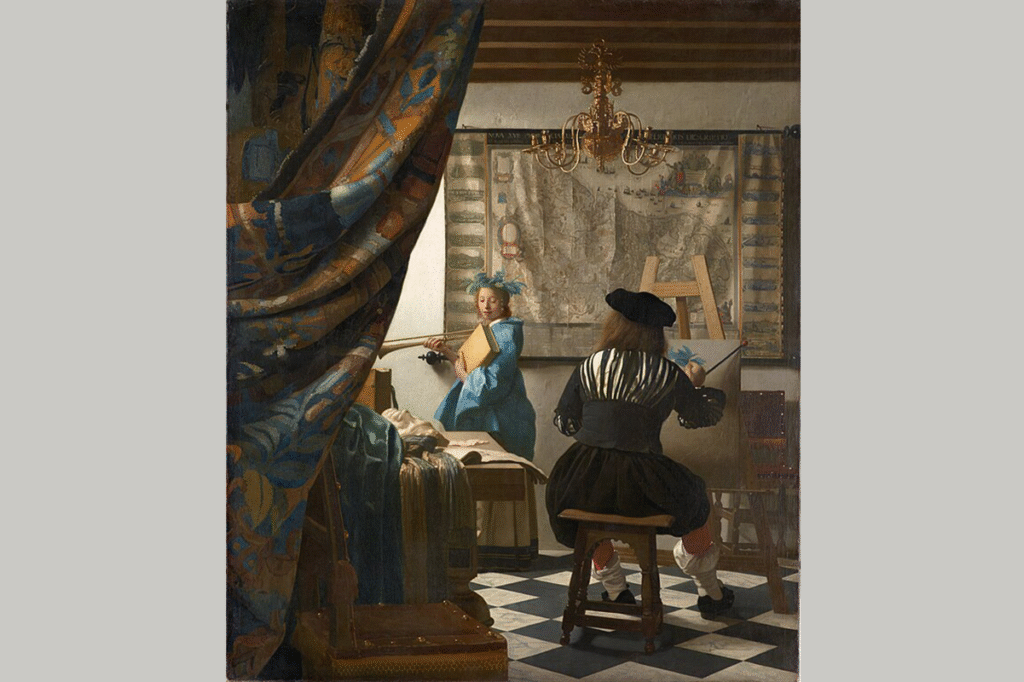 For this comparative essay, I chose Johann Sebastian Bach’s Toccata and Fugue in D minor, BWV 565 and Jan Vermeer’s The Art of Painting (c. 1666-1668). Firstly, Vermeer’s painting is meticulous. The artwork presents an artist working in his studio. This piece has some household elements, such as a map of the Netherlands on the wall, a chandelier on the ceiling, a tiled floor, etc. Part of the success of this painting is that Vermeer is using a technique called linear perspective to create depth and a sense of realism in the scene. He plays with light and shadow in order to direct the viewer’s attention to the main theme: the artist’s work.
For this comparative essay, I chose Johann Sebastian Bach’s Toccata and Fugue in D minor, BWV 565 and Jan Vermeer’s The Art of Painting (c. 1666-1668). Firstly, Vermeer’s painting is meticulous. The artwork presents an artist working in his studio. This piece has some household elements, such as a map of the Netherlands on the wall, a chandelier on the ceiling, a tiled floor, etc. Part of the success of this painting is that Vermeer is using a technique called linear perspective to create depth and a sense of realism in the scene. He plays with light and shadow in order to direct the viewer’s attention to the main theme: the artist’s work.
One of the most striking aspects of Vermeer’s painting is its ability to make you feel like a part of the scene. When you gaze upon this masterpiece, it feels as if you are stepping into the painter’s studio; witnessing Vermeer not just painting but composing poetry in motion with every brushstroke. However, as this is a comparative paper, let’s now turn our attention to Bach’s Toccata and Fugue in D minor.
Toccata and Fugue in D minor BWV 565 is one of the most emblematic compositions of organ. Usually, people relate this piece to something spooky, tremendous, horrible, and sublime; something beyond our mind and intellection that even reason and feelings cannot explain completely. It was composed between 1704 and the 1750s. According to the tale, Bach was testing the organ in one of the churches in Germany, and in an act of improvisation, he composed Toccata and Fugue in D minor. As the title says, this piece has two parts. First, Bach begins with a Toccata, characterized by dramatic and majestic improvisational parts. As soon as the sublimity of the Toccata finishes, Bach begins playing the Fugue, which is the composition when a short part or theme is introduced and then repeated continuously, with a lower dynamic, which grows little by little in ornamentation, dynamics, and volume. Therefore, at the end of the fugue, the listener is delighted by a complex composition of sound.
Both Jan Vermeer’s Art of Painting and Johann Sebastian Bach’s Toccata and Fugue in D minor portray, and express, the skillful talents of these two artists. Nevertheless, what do these two pieces have in common? Let’s reflect a bit more upon Bach’s piece and Jan Vermeer’s Art of Painting and imagine that we are hearing the organ and gazing at this painting for the first time. Whether we love art or not, we are struck by the sublimity and majesty of the masterpiece, and that is the same with Bach. Whether we know something about music and organ or not, when we listen to the Toccata’s part in Bach’s Toccata and Fugue in D minor, we are struck by the notes and the complexity of the melody. Both masterpieces evoke feelings of fear, admiration, grandeur, and greatness. Suddenly, our environment is timeless while we look at the work of art and listen to Bach’s composition. As soon as we return to reality, we can go deeper into the details of Jan Vermeer’s work and Bach’s composition. Then, the fugue’s part helps us dismember the composition, while the painting enables us to see its details and symbolism.
Therefore, the viewer can see that the girl with the trumpet, the book, and the laurel wreath the artist is painting is a muse called Clio. The coincidence is that Clio is the muse of history and music. This detail helps to portray the grandeur of music in Bach’s composition. The map in the background symbolizes space and time, which is remarkable because music is bound by space and time. It has moments of silence and noise that create a glorious composition. Both Vermeer and Bach play with light and shadow to focus our attention on the final resolution of their work. Finally, the fugue is the allegory of the technique of an artist who introduces a short part of the process and then repeats the method over and over again until he gets to the final resolution.
In summary, if painting is poetry in motion, music is poetry in sound. Nevertheless, it is worth highlighting that the technique and its repetition are clever and key points to achieve harmony in a piece of art and a musical composition. Whether in Jan Vermeer’s Art of Painting or Johan Sebastian Bach’s Toccata and Fugue in D minor BWV 565 portray the talent and the effort of men that help the human mind and heart to immerse themselves in the contemplation of beauty through art and music.
Bibliography
- J. S. Bach, Toccata and Fugue in D Minor BWV 565, Germany, Baroque Era, c. 1704 – 1750s.
- J. Vermer, The Art of Painting, Oil on Canvas, Kunsthistorisches Museum, Vienna, Austria, Baroque painting, c. 1666-1668



